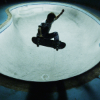Aaron Lieber
Surf Cinematographer and Filmmaker
"I just turn it on, and it works—fast."
Flow State: Behind the Action of Surf Filmmaker Aaron Lieber
From a young age, Aaron Lieber knew how to take advantage of his strengths. He was innately drawn to the outdoors, sports and film, and used this passion to fuel his early work filming friends skate, surf and snowboard. During his adolescent school years, students were presented with the option of submitting work as a written paper or video—the decision was obvious and it offered Lieber yet another opportunity to develop his skills as a filmmaker. He racked up quite a portfolio of work while simultaneously teaching himself Final Cut Pro®, shooting techniques, script writing, directing, and how to tell a story while making a mix of action films and school film narratives. These fledgling steps eventually led him to an internship with TransWorld Surf Magazine’s online editor just as broadband began to bring Internet-based media consumption to the mainstream. Inspired from his internship and only 20 years old, Aaron resolved to make a surf movie. He created a proposal and set off down the obligatory road of rejections until, at last, one group said yes. Armed with a small budget, he embarked on the unknown journey to make an hour-long surf film. Lieber traveled the world filming while juggling 15 units each semester, simultaneously managing to raise double his initial budget. He graduated from college in 2004 with the completion, and release, of his film just two months later.
Fifteen years onwards, and after many improvements to his workflow and equipment, he hasn’t stopped making surf movies. "I did competitive surfing in college and high school," Aaron says, "but I wasn't very good. That's part of the reason why I wanted to make surf films. It’s incredibly diverse and super interesting, plus I’m really drawn to the sport and the ocean. For me, the next best thing to being an athlete is making films about them. But if you’re going to do it right, you need the right tools, and you have to be focused."
Taking SanDisk Professional to the Sea
Focus plays a huge role in the life of any creative professional, but it’s hard to imagine it being more prominent than in the world of surfing. Wave-riding athletes talk about being in a "flow state" of nearly perfect concentration, a mental zone wherein time crawls, sensory consciousness expands, and the body responds instinctively to do-or-die decisions.
In the water, as close to these surfing superstars as he can get, Aaron confesses that he may not share his subjects’ flow state, but he does have a similar zone of focus for his work behind the camera. Naturally, nothing has more immediacy than tending to his camera controls and the quality of his image capture, but this focus also extends beyond the water when it’s time to protect his hard-won footage. As a filmmaker, Aaron may have no craft without capture, but neither does he have a career without his content. Preserving and managing his footage is everything.
Early on, Aaron recorded onto film, then migrated into miniDV tapes. As resolutions, codecs, and the market’s quality expectations scaled, Aaron’s storage workflow had to keep pace. He made the leap into pure digital. In some ways, that made things easier, but it didn’t change that he often operates a one-man show. He shoots, directs, edits—everything. As a result, every facet of his workflow that can be made fast, seamless, and simple must be made so.
One of the more cumbersome aspects of his traditional workflow has been the migration of data from camera media into editing. After working through years of experimentation, Aaron now standardizes his on SanDisk Professional Storage Solutions. As soon as he gets back to his hotel room, Aaron plugs his flash cards into his laptop’s card reader. The laptop copies the cards out to 1TB or 2TB G‑DRIVE® SSDs over USB 3.1. For safety, he makes a second, identical copy onto another set of G‑DRIVE PRO SSDs units.
"I like the G‑DRIVE SSDs because they're small," Aaron says. "I can fit a bunch of them in my carry-on, which can be a big deal when you’re on the road for six to eight months of the year. Traveling as light and efficiently as possible is a key competent for success."
Traveling light can’t mean traveling small, though, at least not in terms of capacity. Aaron usually keeps at least 10TB G-DRIVE SSD on a job, and he rarely feels that this is overkill. He normally shoots 8K V-Raptor® and Sony Alpha A1 cameras, and while he tries not to overuse slow motion in his movies, he finds that shooting 72 FPS offers a lot of creative leeway since it backs down to standard play speeds very cleanly. The trade-off, of course, lies with massive data collection.
"Basically, 1GB is like the smallest file I’m shooting," he says. "That’s only a few seconds. It’s crazy. But every frame is a photo, so if it’s in focus and sharp, I can pull that image and sell it or use it for media purposes around the production."
Unlike most ambassadors, Aaron doesn’t typically have clients expecting near-immediate turn-around of content from the field. Rather, he has the time to amass terabytes of fresh content. Only once he returns home does Aaron leverage the last major benefit of the G‑RAID Shuttles: the speed of Thunderbolt™ connectivity. Even if he doesn’t have colleagues breathing down his neck for dailies, Aaron still has a business to run, and time spent waiting is still lost productivity. By using his Thunderbolt-based G‑RAID Shuttle , Aaron can ingest in hours what would have potentially taken days with a slower connection, and the editing race can begin.
Ocean-Sized Storage
Since 2010, long before becoming an ambassador Aaron has made SanDisk Professional his go-to brand for storage. Other storage labels have come and gone, more from circumstance than choice, but the end result is that his office now boasts over a dozen G-DRIVE units. Sizes range from 1TB to 8TB. In essence, each drive became a sort of time capsule for his work. Aaron would use a USB drive for backup until its capacity was filled, whereupon he would slap a label on it with a date range, then start filling a new drive.
As so many other micro-businesses have found, this "time capsule" strategy works—barely. Too often, the backups feature no RAID protection or other forms of redundancy, so if he were to lose a drive somehow, the data on it would be gone forever. He acknowledges that his past decade has been a form of storage Russian roulette. Even if, as he puts it, "G-Technology makes its drives to be business-grade, not the usual consumer stuff," the laws of probability can’t be skirted forever. Safe practices dictate a better long-term backup approach.
Early in 2015, Aaron invested in a G-RAID SHUTTLE 8. Sporting eight 8TB Enterprise-class drives, the 64TB G-RAID SHUTTLE 8 dedicates one of its drives to RAID 5 redundancy, giving Aaron the peace of mind against accidents without sacrificing the performance required for editing. Ensuring reliability, he says, should always be top priority, because a professional can’t function effectively if he or she is sitting around worrying about data loss.
Right after reliability, though, comes speed. Aaron takes ample advantage of the G-RAID SHUTTLE 8 40Gbps Thunderbolt 3 connection—a must, he says, for handling multi-stream HD projects. However, whether for ingestion, editing, or backup, this upgrade has taken what used to be a bottleneck in Aaron’s storage bandwidth and pushed his workflow’s congestion point back onto his editing workstation. For now, he is content with this, as tasks that recently took hours have now fallen to minutes.
Keeping Focus Close
As much as Aaron Lieber enjoys the G-DRIVE products G-RAID Shuttle 8 workflow, he’s been riding the tides of filmmaking long enough to know that he will eventually need more. Already, he acknowledges that, at his current rate of data accumulation, he will need another G-RAID Shuttle 8 sometime in 2017. He’s also looking forward to upcoming solutions in the Evolution Series that will increase his efficiency in the field. No matter what his needs, though, Aaron feels confident in leashing his ankle to SanDisk Professional's surfboard.
"I’ve had a variety of other drives for a lot of reasons," he says. "I like the look and feel of SanDisk Professional, of course, but somehow they also manage to keep a really high standard of quality while remaining affordable. I mean, literally, I’ve never had a SanDisk-anything go bad. Other drives, yes, but not SanDisk Professional. That’s ultimately what it comes down to."
Aaron also appreciates the simplicity of SanDisk Professional solutions. While he’s no stranger to the technicalities of filmmaking, he has no patience for having to read manuals. With SanDisk Professional solutions, he says, he doesn’t have to. "I just turn it on, and it works—fast."
Simplicity, reliability, and speed allow Aaron to keep his attention off of the mechanics of his business and maintain focus on his creative flow. He makes sure to surround himself with partners who share the same priorities and always strive to help him do his job better.
"Out of all the brands I see, SanDisk Professional is always pushing innovation," Aaron insists. "They’re making new products to help manage these massive footage collections while you’re on the road. Yes, their products can help big filmmakers, but they also care about small filmmakers. They’re asking the right questions and creating solutions to solve my problems."
SanDisk Professional Ambassadors are leaders in their respective fields who use SanDisk Professional products in their day-to-day work lives. SanDisk Professional Ambassadors are compensated for their participation.
SanDisk Professional external hard drives serve as an element of an overall backup strategy. It is recommended that users keep two or more copies of their most important files backed up or stored on separate devices or online services.







